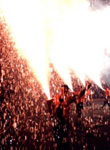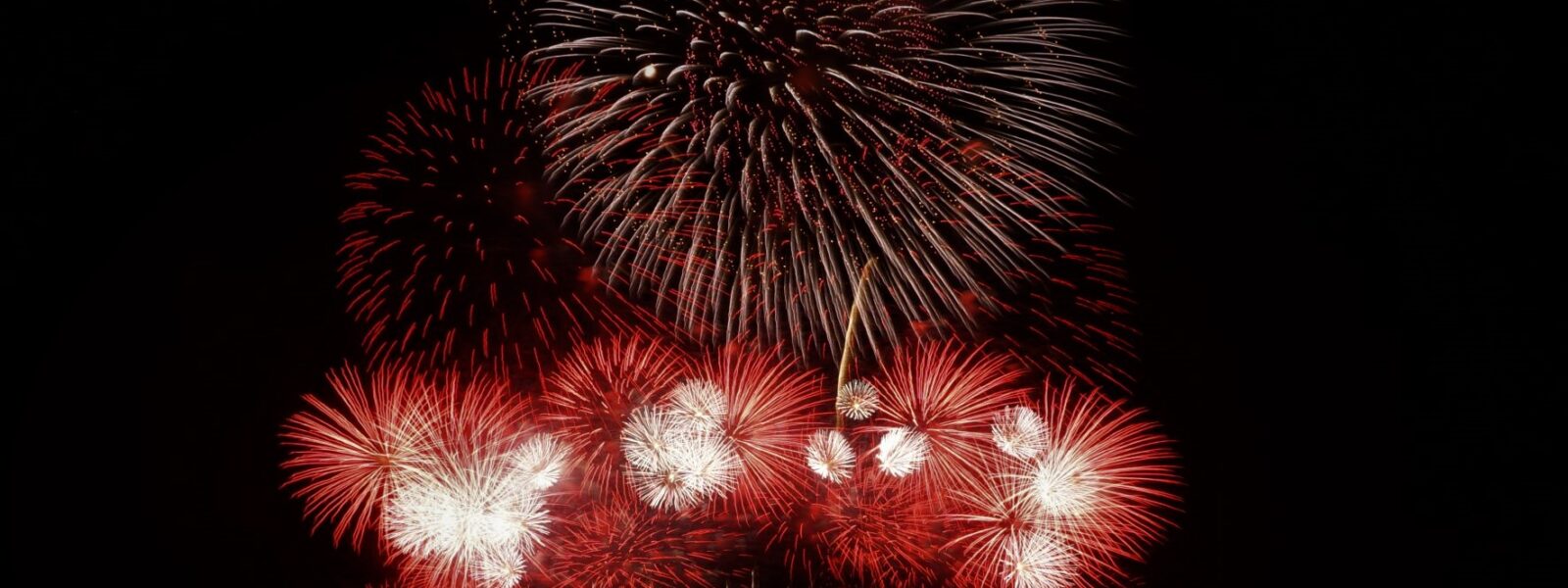General Information
General informations about fireworks
1. Histories of fireworks
1-1. A History of fireworks in Japan
The invention of rudimentary form of black powder, which is a kind of gunpowder mainly used in fireworks, dates back to the late 8th century in China, though at the beginning it was regarded as medicine [Yoshida and Tei 2006]. On the other hand, some researchers argue that the origin of gunpowder can be extended back earlier. Shimizu [1998] insisted that the use of gunpowder had already started in the late 2nd century B.C, while Hosoya [1999] regards that the discovery of raw material saltpeter had occurred during the Han Dynasty (B.C. 202- A.D. 225). Although there are many views about the emergence of gunpowder, it is recorded that the synthesis of black powder began in the period of Chinese Tang Dynasty (A.D. 618-907), and its explosion was shown in front of the emperor [Shimizu, 1998].
On the other hand, some researchers assume that European scientists completed the synthesis of modern black powder and utilized the technology to the weapons, and later to the fireworks [Hosoya, 1999]. At least it is supposed that in 1300s guns were already produced in Italy and spread to Europe to use at wars [ibid].
In the beginning of the 16th century, Italian pyrotechnician fired rockets for the military purposes as pyrotechnics shows [Werrett, 2010]. They were mainly rockets and large set pieces with splashing sparks set around castles and churchyards instead of aerial fireworks. After that, it is said that fireworks spread to the post-medieval European countries by showing them in front of the rulers and the religious leaders at the time. As Werrett [ibid] regarded, the fireworks in the dark might have been displayed as magnificent spectacles fired in public places, probably imitating volcanoes and wars at the period before the electricity was invented.
Meanwhile, the first use of gunpowder recorded in Japan was much delayed compared to those in China. Japanese people encountered weapons using gunpowder in the late 13th century when the attacks by Korean and Mongolian armies occurred [Ogatsu, 1979]. Japanese army should have been surprised at their destructive forces because the wars were different from the fights with swords on horses in the past. Later in the middle of the 16th century, the first import of guns was operated between Portugal. After that, the production of gun secretly started in some areas of Japan [Izawa 1982]. Around this time fireworks displays were imported to Japan. In the beginning of the 17th century, it is recorded that the fireworks show was held in front of the Japanese ruler Ieyasu Tokugawa, when the British King George I’s emissary visited Japan accompanied by a Chinese merchant [Shimizu 1998, Ogatsu 1979]. It is interesting that the road of gunpowder went such a long way round via Europe, though the emergence had occurred much earlier in the neighbour country.
In the beginning of the Edo Era (1603-1868), trades with Spain and Portugal were aborted under the Tokugawa shogunate. Only trades with Holland were permitted between Europe in some restricted areas. At that time gunpowder used for guns was black powder, a material made from niter (saltpeter or potassium nitrate), sulfur and charcoal. As the amount of saltpeter that can be obtained was strictly limited, the production of gunpowder and fireworks started in Japan [Ogatsu 1979]. During the long peace period of more than 200 years, aerial fireworks have spread all over the country. At the beginning black powder was used for the stars in fireworks, and their colors were very dark and indistinct. The import of potassium chlorate as oxidizer in the 19th century made the color of fireworks bright and vivid [Yoshida and Tei 2006, Shimizu 1998]. (Nowadays the substance was replaced to the potassium per chlorate by a safety reason.)
In the early 20th century (1920s), the development of modern Japanese fireworks was accomplished by a prominent pyrotechnician Gisaku Aoki in Nagano [Yoshida and Tei 2006, Muto 1994]. It was the sophistication of Japanese spherical aerial shell, warimono fireworks, and these fireworks were regarded with high esteem of Japanese products. Thus, warimono shells were said to be the characteristic of Japanese fireworks while the cylindrical aerial fireworks played the main role in Europe and North America [Muto 1994]. However nowadays spherical aerial shells became much popular all around the world.
The development of recent fireworks displays can be explained by the increase in music starmine. The introductions of ignitions by electrical match and computing synchronizer are essential both for safety reason and showing dramatic impacts. Pyrotechnicians all over the world use this technology, especially in grand-scale ceremonies such as Olympic events. These massive fire shows held in the wide sky can be easily watched via Internet videos and TV programs from almost anywhere in the world. Thus the difference of fireworks technologies between countries has decreased. In Japan, these technologies began to spread around 1990s and now they create one of the main streams of fireworks events and contests. They are presented as the pyrotechnicians’ expression of skills and aesthetics.
However in Japan, shooting of indivisual warimono shells over No. 8 are still popular in local events. For the celebration of marriage, giving birth, and long lives, people invest for warimono shells in festivals. Fireworks are the seasonal symbol of summer for many Japanese people, connected to their memory of vacations and annual events.
As digested in this section, a history of Japanese fireworks started about 400 years ago. At the beginning both fireworks and gunpowder were imported mainly from European countries. After the change in political situation, the amount of the imports dropped. Then Japan started to product fireworks domestically. Though the history is not as long as those in China, Japan has specialized in the production of warimono shells early in the modern age. Nowadays fireworks displays in Japan have two aspects. They are dynamic fire shows synchronized with music, and expressions of sensitivities of pyrotechnicians.
1-2. A History of fireworks in Mikawa and Enshu
San-en Fireworks is located in Kosai City, the mid-mainland area of Japan. The place was just on the edge of both Mikawa (the eastern side of Aichi prefecture) and Enshu (the western side of Shizuoka prefecture). There are many fireworks production companies and events in this area. For example in the following table, in Aichi prefecture there are 40 fireworks companies that join Japan Pyrotechnics Association (J.P.A.) and the number is the highest in 47 prefectures of Japan. Also in Shizuoka prefecture there are 11 members of J.P.A., and the number of populations per fireworks companies is the third lowest in the top 10 prefectures in population. The statistic indicates that the number of fireworks companies per person is relatively large. Why fireworks productions are such concentrated around Aichi prefecture? The active fireworks production in this area, especially in Mikawa, is closely related to its historical and geographical profiles.
Destribution of the production of fireworks in Japan
| Prefecture | a: JPA members (sub-members)* [companies] | b: Population** [thousand/people] | a/b |
| 1. Aichi | 40 | 7,400 | 250 |
| 2. Tokyo | 17 (4) | 13,000 | 620 |
| 3. Hokkaido | 18 | 5,500 | 310 |
| 11. Shizuoka | 11 | 3,800 | 350 |
* Japan Pyrotechnics Association members, in 2012/3/9
**Population by prefecture, based on the Population Census, 2010
Firstly, 300 years ago the first ruler of Tokugawa Shogunate, Ieyasu Tokugawa, restricted the production of gunpowder except for his homeland Mikawa area after the prolonged wars in Japan. Then the technologies of the treatment of gunpowder were succeeded only between the retainers. Gradually, ordinary people in the area connected these secret technologies to the religious devotion as the fear of fire and gunpowder. Izawa [1982] regards that the circumstance earned the culture of fireworks used in rites, as the protest against the epidemics and disasters.
Secondly, Mikawa is located in the middle of the main road Tokaido, which connects Edo (the former name of Tokyo) and Kyoto (the former capital of Japan) since the 7th century. Thus the governments were eager to carry the territorial policy for temples and shrines around the road. For warriors who pass this area, these religious constructions became the place to pray the fortunes at wars. They connected fires to “the protest against bad lucks”. That increased the chances to hold fireworks events eagerly in Mikawa.
These historical and geographical features affected the development of fireworks in Mikawa and Enshu. There is a unique tradition of fireworks to hold by an arm (“tedutsu-hanabi”) in these areas. Tedutsu-hababi is a cyrindrical fireworks made of bamboo mortars filled with gunpowder and the additives inside. The bottom of the bamboo was closed softly with soil, and the fire sparks straight upward when ignited. The outside of the mortar is tightened with straw rope, and the rope also makes the shooters easier to hold the mortar firmly under their arm during firing. The most characteristics of tedutsu-hanabi is the whole process from the harvesting of bamboo tree to the packing of gunpowder is operated by the shooters themselves. At the beginning of its origin, tedutsu-hanabi was fired and devoted only to local shrines. In the 18th century the culture of tedutsu-hanabi was told to the Enshu area. The shooters in Enshu area developed their own style of fireworks and also succeed that to the day. Nowadays the tradition of tedutsu-hanabi is succeeded and conserved by these local volunteers in both Mikawa and Enshu, and spread to some areas in the country. San-en Fireworks support these shooters in treating the gunpowder and provide the facilities for packing of the pyrotechnical compounds.
One of the largest festivals in Mikawa, Toyohashi Gion Festival in July, is developed from the devotion of tedutsu-hanabi to the historical local shrine, Yoshida Shrine. The festival has the history of more than 400 years. The event has grown to the large fireworks festival held both on the grounds of Yoshida Shrine and the reservation of River Toyokawa. On the event days hundreds of tedutsu-hanabi tubes are ignited by members of the preservation group, besides aerial fireworks and starmines are displayed by enterprises. Hundreds-of-thousands of people visit and watch them. Hence the festival has become one of the important tourism for local economies.
To summarize this section, the fireworks around Mikawa and Enshu have a unique culture of fireworks to hold by an arm, tedutshu-hanabi. The tradition began in the Edo Era, and developed under the historical and geographical circumstances. The most significance of the culture of fireworks in this area is that the tradition of tedutsu-hanabi has been succeeded and preserved by local residents’ initiative besides the local government.
 |  |
